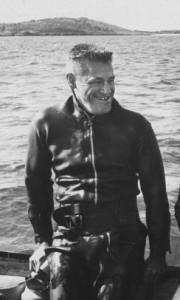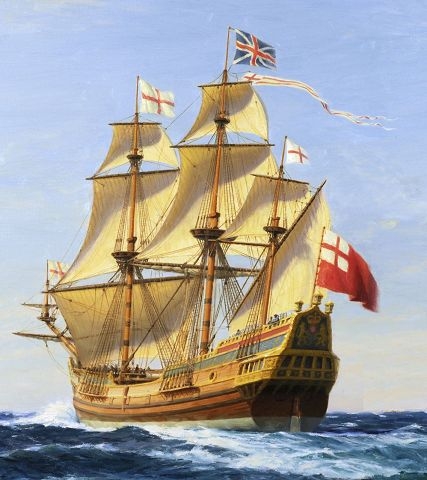The Search To Find The “Sea Venture” Wreck
 Over the centuries Bermuda’s extensive coral reef system has become a graveyard for literally hundreds of vessels — including a 300-ton 17th century English merchant ship which changed the course of the island’s history.
Over the centuries Bermuda’s extensive coral reef system has become a graveyard for literally hundreds of vessels — including a 300-ton 17th century English merchant ship which changed the course of the island’s history.
The “Sea Venture” was the flagship of Admiral Sir George Somers’ relief fleet dispatched from England in June, 1609 to re-supply and revive the failing Jamestown colony in Virginia.
In late July the fleet sailed into a hurricane and Admiral Sir George Somers’ flagship was separated from the other vessels.
“For three days and four nights, all hands — crew and passengers, noblemen and commoners — pumped, bailed, cast trunks and barrels overboard, and jettisoned much of the ship’s rigging, while sailors, lighting their way with candles, stuffed the leaking hull with whatever came to hand, even beef from the ship’s larder,” Columbia University historian Alden T. Vaughan has said.
“Many distraught souls, resigned to a watery death, bid their friends farewell or took refuge in drink. But ‘it pleased God’, [a] survivor gratefully recalled, to push the ‘Sea Venture’ within three-quarters of a mile of Bermuda, where it ‘fast lodged and locked’ between coral boulders.
“All 150 passengers and crew rode the ship’s boats to solid land.”
The castaways spent 10 months in Bermuda, constructing two new vessels — “Deliverance” and “Patience” — out of local cedar and parts which were salvaged from the “Sea Venture.”
They eventually reached Virginia in May, 1610 but when reports of their time in Bermuda reached England plans were set in motion which resulted in the permanent settlement of the island in 1612.
Marine artist Deryck Foster’s painting of the “Sea Venture”
For centuries the precise location of the “Sea Venture” wreck remained unknown.
But with the 300th anniversary of the island’s accidental settlement approaching in the late 1950s, a concerted effort was made by local historians and divers to identify the remains of Sir George Somers’ flagship.
“American Heritage” magazine has reported how during the summer of 1958 Edmund Downing [pictured at top], an amateur skin diver and a descendant of one of the voyagers aboard the “Sea Venture”, joined the divers, historians, and archaeologists searching for the wreck.
Mr. Downing spent the summer diving near a break in the reefs off the eastern end of Bermuda and on October 18 finally spotted the faint outline of the keel and ribs of a ship.
A salvage operation launched the following summer — which included Mendel Peterson of The Smithsonian Institute and Bermudian shipwreck authority Teddy Tucker – turned up pottery fragments, part of an ax handle, and a pewter spoon — all dating from the right period.
But the team also discovered a cannon which was later identified as dating from a later century.
Discouraged, the Bermuda Government cut off funding for the investigation.
So matters rested until 1978, when the newly formed Bermuda Maritime Museum Association obtained a permit to return to the site.
In June. 1980 divers using a water-suction dredge uncovered what remained of the keel and ribs, measured and photographed them, and then recovered them to prevent further deterioration.
Artifacts found on this and earlier dives were authenticated by Ivor Noel Hume, resident archaeologist at Williamsburg, Virginia.
In 1982 Jon Adams, a marine archaeologist working on Henry VIII’s man-of-war “Mary Rose”, visited the wreck site.
In his view the wreck was old enough to be the “Sea Venture”, and he even spotted evidence of the hull having been stripped to build the “Deliverance.
“It’s rather like the ‘Mary Rose’,” he said. “We never found anything that actually said ‘Mary Rose’, but we found the same weight of circumstantial evidence.” It seems likely the cannon found in 1959 was misidentified.”
Read More About
Comments (2)
Trackback URL | Comments RSS Feed
Articles that link to this one:
- Video Preview: LookBermuda’s Sea Venture Film | Bernews.com | March 7, 2014



I’m an 11th great grandson of Stephen Hopkins and a Member of Jamestowne and Mayflower under his name. Yes, I know there are hundred of thaousands, is not millions of descendants…so no big deal.
My question: I would have thought that the Gov. of Bermuda would have recovered what was left of the Sea Venture, conserve it and then put it on Disply for all to see.
What are your thoughts on the subject?